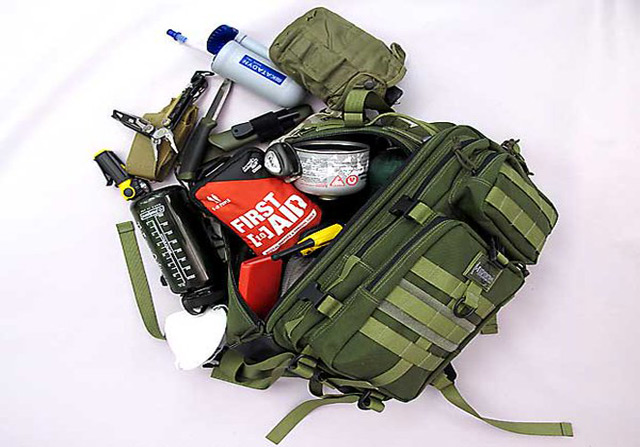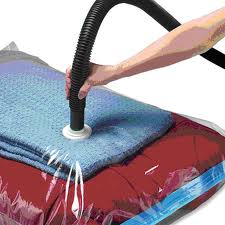Click Here To Join Our Telegram Channel for FREE daily tutorials!

I’ve been trying to put together the perfect bug-out bag for a long time now. I kept taking things out and replaced them with lighter, smaller alternatives. Some of them ended up back in because I realised they were better and safer, and my family’s safety comes first. However, I’m still not over trying to shave off as much weight as possible, looking for ways to save space to fit in more crucial items, while keeping it light enough to carry around without breaking my back.
In time, I learned that there are certain techniques you can successfully use to save maximum space while keeping everything necessary.
#1: Fill every inch of space
Take boots for example. If you’ve got a pair of spare boots in your bug-out bag, fill them up with other items, whatever you can get in there. Roll underwear and socks tightly and shove them inside your shoes.
Better yet, you can use them to protect fragile objects. Roll the fragile item in a piece of cloth (that you can use further, such as a bandana or a shemagh). Put it in the boot, make sure it stays fixed and, eventually, if there’s more room, cover everything with a pair of rolled socks, just to make sure it’s fully protected.
#2: Use space bags

In case you don’t know what space bags are or how to use them, here’s a video that shows you every step of the way, as well as what you should and should’t pack in them:
These bags saved me a whole lot of space in our bug-out bags. And I do mean a WHOLE lot. But here’s the problem with them: once you open them, everything in there is going to get back to its regular size. Therefore you won’t be able to pack it back up when you don’t need those clothes anymore because you’d need a vacuum to reseal the bags.
This is a downside that I’m not happy about, but I decided to use space bags anyway. It’s better to carry around some extra clothing when I’m not using it, then to suffer from cold or wear miserable clothes simply because I have no other change in my bug-out bag.
Now, it’s your choice whether you use space bags or not. I suggest you try them out and see if it’s convenient to you. You can’t really make the decision until you see just how much space you can save.
#3: Load up on freeze-dried foods
There’s a bunch of reasons why you should take (mostly) freeze-dried food with you when you bug-out. Here are the most crucial 3:
– It takes up little space and it’s extremely light-weight
Freeze-dried food loses 98% of its water, so it literally cannot get any lighter than that!
– It lasts up to 30 years
However, you have to take temperature into consideration. If you store it at high temperatures or subject it to brutal temperature changes, it will spoil sooner.
– It offers variety
This is my favourite thing about freeze-dried food: it’s diverse. I can pack the ones my family loves and offer them the meals they’re familiar with, even in stressful times of disaster. This is the kind of comfort that everyone needs when SHTF.
#4: Use multiple-use gear
And when I say multiple-use gear, I’m not referring strictly to those knife + fork + spoon + compass + whistle sort of tools. Those are great if they’re good quality. If they’re cheap, don’t bother to buy them. They won’t save space, just the contrary. They’re absolutely useless, so why carry useless things with you when you could fill that space with items that could actually save your life? My advice is to invest in a good multiple-use tool or not invest at all.
But besides these tools, there are plenty of other items with multiple purposes that can save a lot of space. For example:
– Bandanas or shemaghs (cover your head if it’s too sunny, prop a broken limb, protect your airways from wind and dust, stop the bleeding etc)
– 550 cord (you can make one of those 550 cord bracelets and wear it around your wrist, not in your bug-out bag)
– Potassium permanganate (water purification, wound sterilization, fire starter)
#5: Replace tents with tarps
Warning: I do NOT suggest this method during the cold season!
Replacing a tent with a tarp may be the most clever thing you can do to shave off weight off your bug-out bag. A tarp is a multiple-use item, it’s light-weight, resistant to wind and rain and it’s very easy to carry around.
You can spread it on the ground if it’s wet or muddy. You can make a perfectly secure shelter if you want to protect yourself from rain or sunlight. You can use it as a wind stopper. You can sit down on it to eat with your family. You can also wrap other items in it to prevent them from getting wet. You can make a stretcher so you carry injured people around. Or you can even wrap a tarp around a person, to maintain body heat.
However, replacing tents with tarps is not the best idea during the cold season, as tarps do not offer full isolation. That’s why I only recommend tarps in spring and summer.
By Alec Deacon
This Crazy Off Grid Device Literally Makes Drinkable Water From Fresh Air:
According to NASA, the U.S. is expecting a 100-YEAR LONG MEGADROUGHT.
It's already begun. Ask the farmers in California. They know.
Every survivalist knows that water is of critical importance. You NEED an independent water source that you can count on!
As an interesting "survival rehearsal" - imagine that you turned the tap on right now and nothing came out. How long would you last?
But what if there was another water source literally hidden in plain sight. That's right, I'm talking about the atmosphere!
The amazing thing about getting water from the natural moisture in the air... is that it is ALWAYS available.
This gives you real water security!
Learn more about how to tap into "Nature's secret water reservoir" and stay hydrated when TSHTF!
Watch the video:
😳 What Tinnitus Does To Your Brain Cells (And How To Stop It)
After 47 years of studies and countless brain scans done on more than 2,400 tinnitus patients, scientists at the MIT Institute found that in a shocking 96% of cases, tinnitus was actually shrinking their brain cells.
As it turns out, tinnitus and brain health are strongly linked.
Even more interesting: The reason why top army officials are not deaf after decades of hearing machine guns, bombs going off and helicopter noises…
Is because they are using something called "the wire method", a simple protocol inspired by a classified surgery on deaf people from the 1950s...

I Can't Help Showing This Off:
If you haven't heard of Claude Davis yet do yourself a huge favor and watch this video.
One of the smartest guys I ever had the pleasure of meeting, Claude set-up a unique prepping system that changed his life forever.
I already tried it myself and let me tell... you I was completely blown away... His surprising tactics could make your life easier and give you the peace of mind you deserve.
Don't just take my word for it... watch his short video and decide for yourself.

Most People Don't Have The Guts To Try This:
An amazing discovery in an abandoned house in Austin, Texas: A lost book of amazing survival knowledge, believed to have been long vanished to history, has been found in a dusty drawer in the house which belonged to a guy named Claude Davis.
Remember... back in those days, there was no electricity... no refrigerators... no law enforcement... and certainly no grocery store or supermarkets... Some of these exceptional skills are hundreds of years of old and they were learned the hard way by the early pioneers.
>> Click here to find out about them now
We've lost to history so much survival knowledge that we've become clueless compared to what our great grandfathers did or built on a daily basis to sustain their families.
Neighbors said that for the last couple of years Claude has tried to unearth and learn the forgotten ways of our great-grandparents and claimed to have found a secret of gargantuan proportions. A secret that he is about to reveal together with 3 old teachings that will change everything you think you know about preparedness:
>>> Click Here To Watch His Short Video <<<

More Off-Grid And Survival Resources:

What REALLY Happens When You Bury a Shipping Container? (Hint: It's A Bit Crazy...)
Shipping containers are all the rage - but if you are thinking about buying one, you MUST watch this video first:
There's a general belief that if you bury a shipping container you can create an awesome root cellar / storm shelter / survival bunker.
But is a shipping container strong enough to handle the pressure?
Watch the video to see what happens:
What Really Happens When You Bury a Shipping Container? (Click To Watch Video)









VERY WELL DONE Alec.
This is a great resource for putting together your 72 hour bug-out-bags. It goes through step by step and breaks it down into a 26 week plan. Take the “Overwhelming” out of putting your kits together.
http://www.yourownhomestore.com/your-own-72-hour-kit-plan/
I agree Jessica…but age DOES come a factor, as well as practice. I am 68, medium build, with a partially paralyzed right arm, so THAT weighs in on the practical side. My wife is over weight at present (due to physical problems), and has NO experience on bikes, (even as a child!?!). Another factor. And, we presently cannot ride our bikes around safely, except within the Apt. complex, (which is small), so, another factor. Nonetheless, we’ve bought two “mountain / all terrain bikes, and are in the process of getting new tires[4], tubes[4], & repair kits [3]. I’ve learned through hard knocks, that CIRCUMSTANCES MUST BE A STRONG INDICATOR of what is a “GO”, and what isn’t. Adaptability, planning for the worst case, and practicing the various plans, (for various circumstances), will be ESSENTIAL to succeed during crisis. “K.I.L. / K.I.S.S. / K.I.S.” (Keep it light, simple, and smart!
Something I have in my BOG is several heavy bread bags. Why? I can carry water in them, wrap my feet in them, protect things that need a bit of padding, stuff them with leaves and make a pillow, etc. Better brand bread has the better bags(and, cheap white bread doesn’t do much for you anyway…